

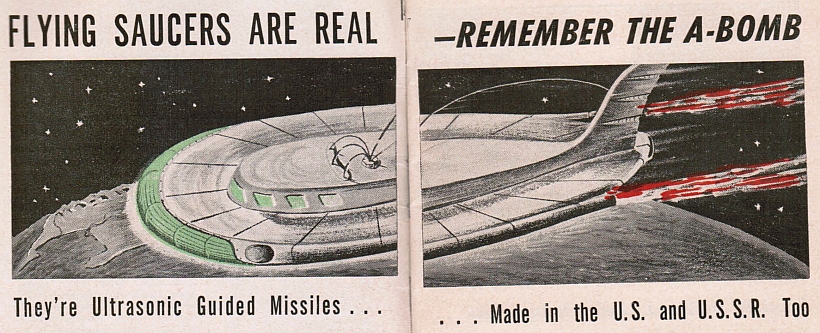
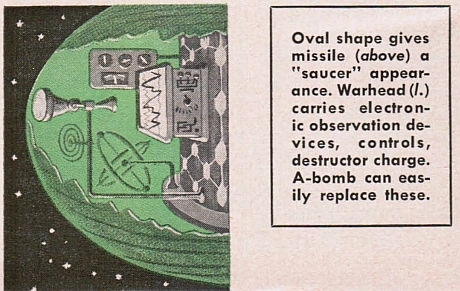
The flying saucers are real. They are guided missiles — both American and Soviet. The inescapable conclusion from world-wide reports is that the Red saucers are launched from Atomgrad #3, a heavily-guarded missile center in a barren waste near the Finnish border. Swedish authorities have detected their passage as they hurtled across Scandinavia in a direct line for this hemisphere. Other Red launching sites are in Siberia.
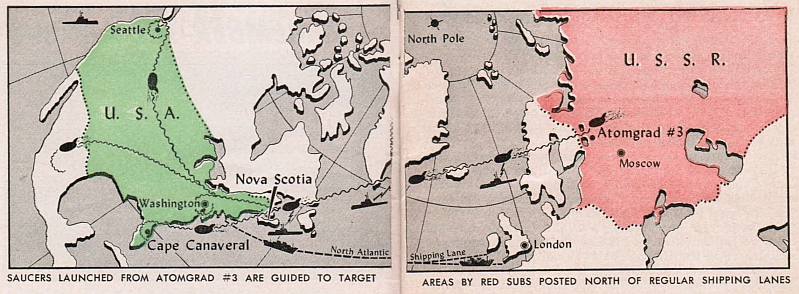
The Soviet missiles are crewless, between 50 and 75 ft. in length, about 14 ft. deep. Rockets provide their main power source but they also carry auxiliary motors, possibly jets. Ovoid in shape, they reach altitudes of 80-100,000 ft., attain speeds in excess of 2,500 mph.
Loaded with cameras and electronic observation devices, the missiles seem to have but one mission at present — to reconnoiter U.S. atomic and military installations. They could as easily carry atomic warheads.
The Soviet missiles are remote-controlled. Red submarines, posted strategically in a chain across the Atlantic (see map), are equipped with electronic monitor boards to guide the missiles through each sub’s “control area.” Thus, a missile originally launched on a course that would place it over Washington, D.C., may be diverted by a sub off Nova Scotia (where unidentified subs have been reported) to a course aimed at the Brookhaven Laboratories on Long Island, close to Manhattan.
The Red saucers need not return to base to deliver their reconnaissance data. Their findings, including aerial photos, automatically beamed to a sub or other secret station, are reproduced and delivered to intelligence headquarters in Moscow. To prevent its falling a into non-Red hands, each missile carries a high-explosive destructor charge which can blow it to bits the instant a button on the sub is pressed.
The Soviet long-range snorkel submarine program for guided missile work was reported by Allied intelligence as far back as ‘48. These subs, developments of the German type XXVI, which had a 1,160 ton displacement, can cruise underwater at the phenomenal speed of 24 knots and remain submerged indefinitely.
For 36 months the U.S. has been working frantically to keep ahead of Russia in the guided missile field. Dr. Karl Compton, one of the nation’s great scientists, has envisioned huge crewless missiles screaming through the ionosphere at 6,000 mph. Said Dr. Compton in 1949: “. . . the picture of smashing a vital electronic development on the outskirts of Moscow from a launching pad somewhere in the United States is not pure fantasy.”
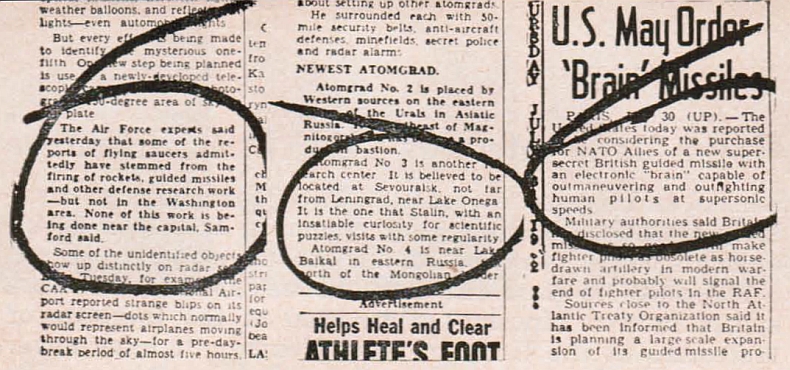
Today, U.S. rockets are being launched from the Joint-Services proving grounds on Cape Canaveral in Florida. These rockets carry electronic devices, can carry atomic warheads. Should one go out of control, a scientist at the base hits the “destructor button” on his control board and an explosive charge in the rocket blows it up.
Military authorities will admit that flights of as long as 500 miles have been made by these guided missiles over the Caribbean. Reports of saucers and other mysterious “objects” sighted in this area frequently refer to these missiles. Our officials aren’t worried about these reports. They are jolted, however, by the 400-odd “unexplained” saucers and fireballs which have crisscrossed our skies, appearing in their biggest concentrations over vital atomic and defense centers.
Russian work on huge rockets began long before German. In 1903, Dr. K. E. Ziolkovsky completed 10-year study of rocket possibilities — even space travel. Later, Soviet sponsored him in secret work; Stalin honored him in 1932. Grasping future importance of rockets, Reds set up 2 research centers in 1920, by 1936 were building rocket to ascend 70 miles. Today, Reds are planning artificial satellite.
“Of course flying saucers are real,” declared a regular U.S. Air Force officer stationed in New Mexico. “They are not mass delusions. Don’t be sucked in by denials in publicity used to cover up AF investigations. Flying saucers are regularly seen over Los Alamos . . .”
During WW II, U.S. pilots in Europe and in the Pacific reported glowing globes, mostly green, which followed their planes at fixed distances, made no hostile moves. They just “seemed to watch,” pilots reported. Intelligence took the matter seriously.
In 1945, following detailed reports by B-29 crews flying missions over Honshu, the 21st Bomber Command’s intelligence officers decided that the fireballs were remote-controlled guided missiles.
Recently, fireballs have been seen over Korea, Alaska and the southwest U.S. The Pentagon is particularly disturbed because they resemble American developments which were considered exclusive and top secret.
Attempts to pass the fireballs off as meteors were spiked by Dr. Lincoln LaPaz, head of the Institute of Meteorics [Meteoritics] at the Univ. of New Mexico. “I have never seen a natural meteor with the characteristics of the yellow-green fireballs,” he told PEOPLE TODAY. “Meteors blow up with a loud explosion. These disintegrate with complete absence of sound. Sightings here and in Scandinavia lead me to believe that fireballs and the so-called saucers may be guided missiles — some possibly ours, some possibly Russian. In any case, they are Earth-born.
“It is possible that the yellow-green fireball is not the missile itself but the remaining part of a missile in the final phase of self-destruction. It does not explode — it simply evaporates in a flash of light.”
Said Dr. LaPaz: “Compare the saucers with the atomic bomb. If someone had asked a Manhattan Project official for an explanation of the brilliant mushroom of light at Alamogordo, he would have received a blank stare and been told that no such thing had ever happened.”
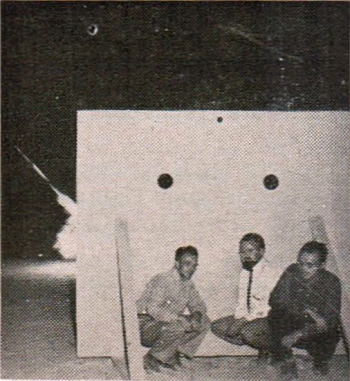
Man-made meteors, attaining speeds of some 17,000 mph, are produced by Dr. John Rinehart (I.) and associates at the Navy Guided Missiles Center in the Mojave Desert. The artificial meteors are small pellets of various metals, propelled by a top secret “gun,” probably a specially shaped explosive charge. High-speed cameras study them in flight. Purpose: To determine best shapes and materials for rockets, guided missiles.
See also article: Flying Saucers Are Guided Missiles
|
|
|
|
|
|
|
|
|
|